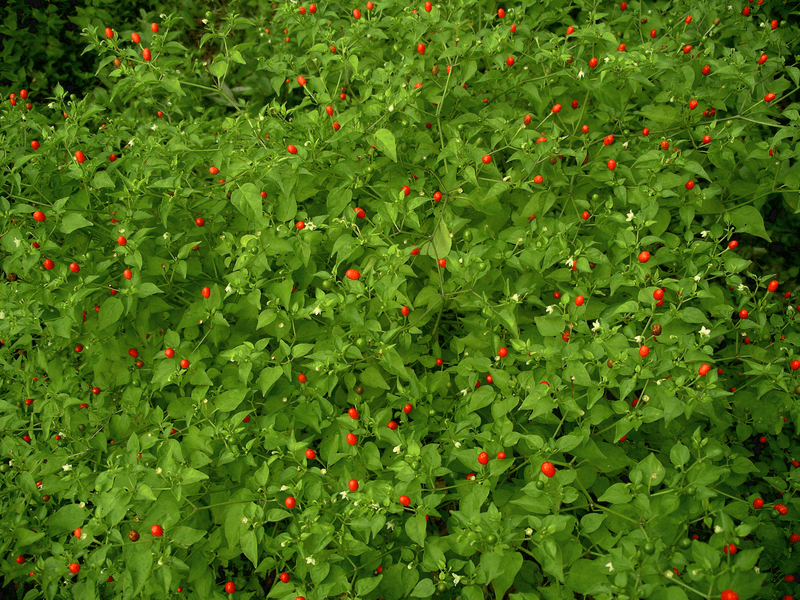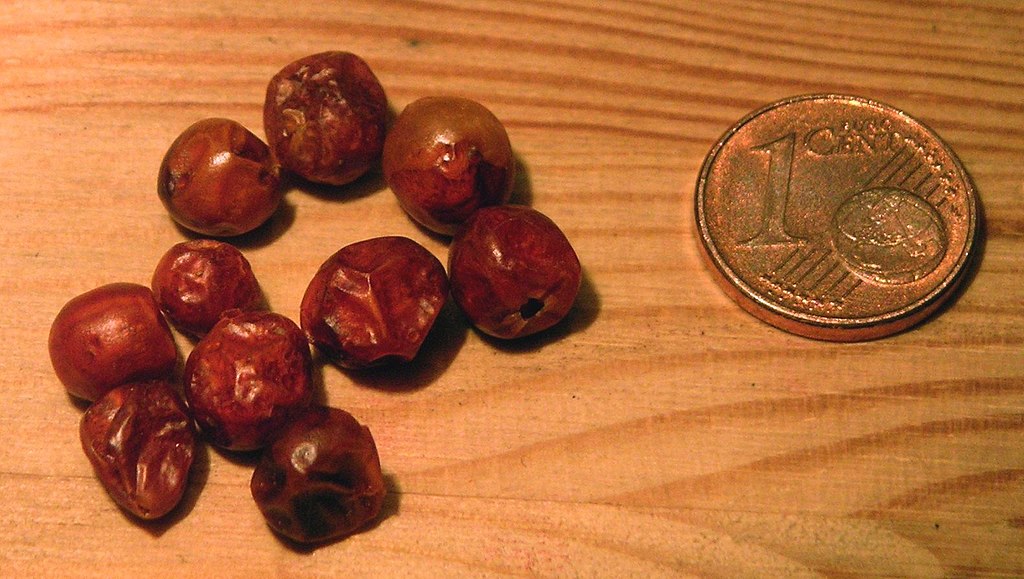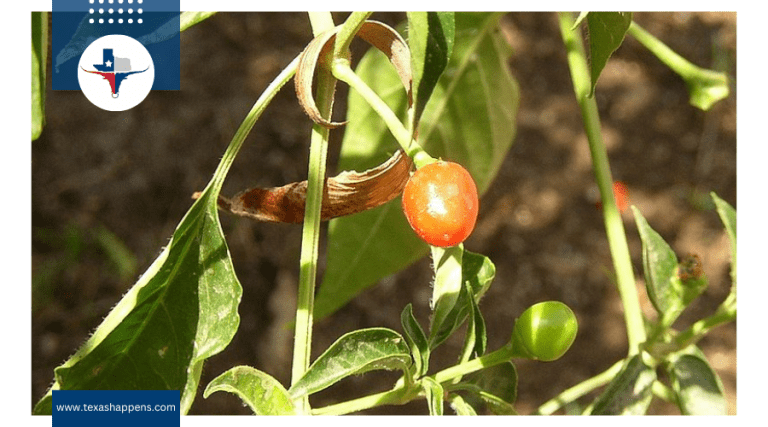anonymous, Chiltepin mexico sonora, CC BY-SA 3.0
Among the myriad of chili peppers used around the world, the chiltepin stands out for its rich history, bold flavor, and cultural significance. Known as the “Mother of All Peppers,” this tiny yet mighty pepper holds a unique place in culinary traditions, particularly in the Americas. Beyond its fiery kick, chiltepin peppers carry a legacy that stretches back thousands of years, linking modern cuisine to ancient practices.
So, what makes this pepper so special? Let’s explore!
Chiltepin peppers, with their Aztec-rooted significance, are more than just a spice; they’re a fundamental link to early agricultural practices. Their name, derived from the Nahuatl words “chile” and “tecpintl,” hints at their diminutive size but immense impact.
Dating back to 7000-9000 BC, chiltepin peppers are among the primary domesticated chiles, underscoring their historical and cultural significance in Central-east Mexico. The Aztecs didn’t just use them for flavor but also integrated them into traditional uses, such as medicinal remedies and ritualistic ceremonies, highlighting their multifaceted role in society.
Recognized as the only native pepper to the United States and designated as Texas’s state native pepper in 1997, chiltepin peppers are deeply rooted in North American history. They serve as the ancestor of all chile varieties and have shaped the culinary landscape profoundly. Even Thomas Jefferson showed interest in this pepper, experimenting with chiltepin seeds in his garden, which speaks volumes about its agricultural importance.
- Cultural Significance: A bridge between ancient and modern cuisines.
- Traditional Uses: From medicine to rituals, versatility shines.
- Foundational Role: The ancestor paving the way for chile varieties.
Heat and Flavor Profile
You’ll find chiltepin peppers packing quite a punch, with their heat measured at a fiery 40,000 to 100,000 Scoville Heat Units. This range places them considerably hotter than jalapeños, making them a thrilling choice for heat enthusiasts. With their small, round shape and lively scarlet red color, chiltepins look like tiny berries, but don’t let their size fool you—they deliver intense heat.
The spice balance of chiltepin peppers is remarkable. Their earthy, sharp, and mildly smoky flavor profile works wonders in improving dishes. Just a pod or two can transform the taste of soups, salsas, and sauces, adding a bold flavor without overwhelming the palate. This makes chiltepins an excellent choice for those who seek to uplift their culinary creations with a touch of fiery sophistication.
Careful measurement is crucial when using chiltepins, as their high capsaicin content not only brings heat but also offers potential health benefits like metabolism enhancement and pain relief. So, when you’re looking to spice things up, keep in mind that chiltepin peppers offer both a kick and a unique flavor improvement, perfectly balancing heat and taste.
Culinary Applications
When you investigate the culinary applications of chiltepin peppers, their versatility quickly becomes evident. Regardless of being fresh or dried, these fiery little gems bring a distinct earthy and mildly smoky flavor to your dishes. In salsa recipes, just one or two pods are enough to transform a simple blend into a lively masterpiece. Their powerful punch means you can use them sparingly while still achieving a bold flavor profile.
Chiltepins shine in traditional Tex-Mex cuisine. Combine them with vinegar for tangy hot sauces that boost your meals, or sprinkle them into soups and stews for an unexpected kick. Chefs love using chiltepins in a variety of dishes, from creamy sauces to rich chili. You can even investigate pickling techniques to preserve their unique flavor, adding depth to your culinary creations.
Health Benefits
They’re packed with nutritional value, being rich sources of vitamins A and C. These vitamins are essential for enhancing your immune health and ensuring your body functions smoothly. But the benefits don’t stop there. Chiltepin peppers contain capsaicin, a compound known for its medicinal uses. Capsaicin may help relieve pain and has been linked to potential metabolic benefits, which could assist in weight management.
The antioxidant properties of chiltepin peppers play an important role in reducing inflammation, thereby enhancing your cardiovascular health by promoting better blood circulation. If you’re looking to support your digestive health, chiltepin peppers can stimulate the production of digestive enzymes, making them a smart inclusion in your diet. Their heat can also induce sweating, aiding in temperature regulation and detoxification, which contributes to overall wellness.
Regular consumption of these potent peppers can be a game-changer for maintaining a healthy lifestyle. By incorporating chiltepin into your meals, you’re not just adding flavor but also tapping into a wealth of health benefits that can strengthen your well-being.

Chiltepinster, Chiltepin Cluster, CC BY-SA 3.0
Ecological Significance
Chiltepin peppers hold significant ecological value, serving as a vital food source for fruit-eating birds like the mockingbird and wild turkeys. These birds play an important role in wildlife interactions by dispersing the seeds of chiltepin peppers, which helps maintain and improve the biodiversity of the region. A single chiltepin plant can thrive for 25-30 years, providing a long-term resource for diverse wildlife and contributing to the ecological stability of Texas.
By thriving across a wide range from the southern U.S. to northern South America, chiltepin peppers demonstrate remarkable adaptability to temperate climates. This adaptability not only supports local flora diversity but also sustains the habitat for numerous species. Their presence is vital in the improvement of biodiversity, as they form part of the complex web of life that supports ecological balance.
Harvesting and Availability
Hand-harvesting chiltepin peppers is a labor-intensive process due to their tendency to grow in hard-to-reach areas. You’ll often find these tiny peppers clinging to bushes in Texas’ wild landscapes. Since they thrive naturally rather than in agricultural settings, foraging techniques are essential for gathering them. You’ll need to develop a keen eye and nimble fingers to pick these fiery gems tucked among dense foliage.
During the harvesting season, usually late summer to early fall, seasonal challenges arise. The peppers’ availability can be unpredictable due to weather conditions impacting their growth. Despite their abundance in the wild, chiltepins aren’t as readily available in markets as jalapeños. This scarcity is partly because local foragers and culinary enthusiasts snap them up quickly, appreciating their unique flavor and heat.
Storage and Preservation Tips
To maintain their freshness, chiltepin peppers should be stored in airtight containers in a cool, dark place. This setup guarantees that the peppers will remain viable for 1-2 years. The ideal storage temperature is between 60°F and 72°F, with low humidity levels to prevent spoilage. These storage methods are crucial for retaining the peppers’ bold flavor and heat.
To extend their shelf life, consider freezing them. Use double-bagged sturdy freezer bags and aim for a freezing duration of no longer than one year to avoid the dreaded freezer burn. Freezing is an excellent preservation technique that maintains their spicy kick, allowing you to enjoy them year-round.
You can also investigate other preservation methods like drying and pickling, which are fantastic for maintaining their robust flavor. Rehydrated chilies offer versatility in the kitchen, and don’t discard the rehydration water—it’s perfect for enhancing sauces.
- Drying: Preserves the chiltepin’s intensity and makes them easy to store.
- Pickling: Adds a tangy twist while extending shelf life.
- Freezing: Keeps peppers fresh and fiery for up to a year.
These techniques guarantee your chiltepin peppers stay flavorful and ready for use.
Cultural Events and Celebrations
Celebrations in Texas often revolve around the lively culture of peppers, with chiltepin peppers taking center stage in varied events. These tiny, fiery peppers are not only a culinary delight but also a reflection of Texas’s rich BBQ heritage, where they can amplify the flavor of smoked meats and unique culinary experiences. When you attend the annual Jalapeño Festival in Laredo, you won’t just be experiencing jalapeño-inspired dishes. This dynamic festival also shines a light on the cultural significance of chiltepin peppers, a staple in Texas. You’ll find that these tiny, fiery peppers are a cherished part of the local flavor, integrated into assorted culinary delights.
In Austin, the Hot Sauce Festival is a must-visit for pepper enthusiasts like yourself. This event showcases local hot sauces, many of which creatively incorporate the bold, spicy essence of chiltepin peppers. It’s a fantastic opportunity to see how these peppers are celebrated in different culinary applications, adding distinct flair to every dish.

User:Carstor, Capsicum annuum chiltepin dried, CC BY-SA 2.5
Wrapping Up
From its ancient origins in Mesoamerica to its role in modern kitchens, this tiny but powerful pepper carries a legacy that transcends time.
Its fiery heat and bold flavor remind us of the rich history behind the ingredients we use today. As we continue to savor and celebrate chiltepin, its story serves as a reminder of the importance of preserving culinary traditions and respecting the natural world that provides these extraordinary flavors.


